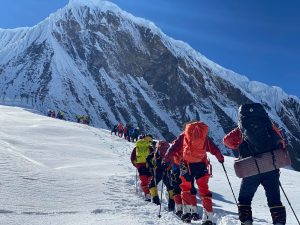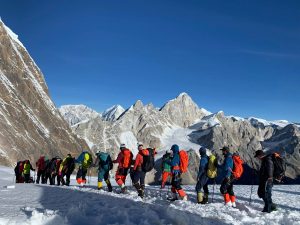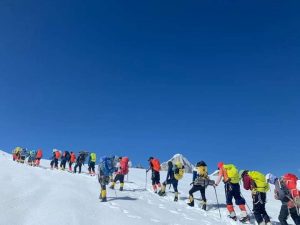2-12
Adventure
Tea House / Tent
6159 m/20201 ft
B/ L / D
Flight / Private Car
Mar - May & Sept - Nov
Why Nirekha Peak Expedition
- Summit Nirekha Peak at 6,169 meters.
- Journey across the Gokyo Valley, consisting of a chain of five mountain lakes, hiking up to Gokyo Ri for breathtaking views of Everest, Cho Oyu, Pumori, Lhotse.
- Crossing Cho La Pass at 5,420 meters.
- Nirekha Peak Summit has an excellent view of the world’s largest glacier, Khumbu.
- Experience authentic Sherpa culture and tradition amid the world’s highest mountains.
Nirekha is one of the most captivating peaks in Nepal. This fascinating peak is newly opened and categorized as a grade ‘A’ climb by the Nepal Mountaineering Association. A great summit on the border of the Himalayan range, Nirekha Peak can be attempted by both novice and experienced climbers, although it requires some technical skill in mountain climbing. Before attempting to climb Nirekha Peak, the climber should undertake some training about climbing and practice the technical aspects of climbing. Trekkers and Climbers can attempt the summit of Nirekha Peak through using two routes, trekkers/climbers can either choose the Lake Base Camp or Kanchung Base Camp route, as each offers different challenges. Kanchung Base Camp route is more accessible and shorter when compared to the Lake Base Camp route. The climbing route is mostly full of ice and snow, so trekkers may need help from an experienced climbing guide. To reach the top is quite tough, even though once you arrive at the top, you will be amazed by the spectacular view of many high Mountains in Nepal, including Mt. Everest, Mt. Nuptse, Mt. Lhotse, Mt. Cho Oyu and other neighboring Himalayan ranges.

Some technical Skills might be handy
Nirekha Peak is one of the most technically demanding adventure climbs in Nepal, which requires fixed ropes, ice screws, Jumpers, main rope, and a fully trained Sherpa guide to support you to overcome the climb. Before attempting Nirekha Peak, climbers should take a climbing training course and learn various climbing skills and techniques such as; ascending and descending in a straightforward climb, fixing rope, glacier travel and many more. The Nirekha Peak Climbing Trek is relatively straightforward but filled with ice and snow which requires an ice ax, crampons, and some fixed rope while climbing. So, climbing training will surely boost your confidence and ensure you have all the necessary climbing skills to scale the summit successfully.

The best season to successfully summit Nirekha Peak Climbing
Autumn (September to November) and spring (March to May) are the best seasons for climbing and mountaineering in Nepal. In these seasons, the weather is mostly clear and fine, and the temperature is also moderate which will enable climbers to enjoy the most beautiful views without any obstruction. The spring collects gorgeous flowers, plants, and rare animals, which will surely add more excitement during climbing. The Nirekha Peak trail is also very much suitable for travel during Autumn as well.
An adventurous trek
The Nirekha Peak Climb begins with an adventurous flight from Kathmandu to Lukla, the gateway for all Everest region treks. From Lukla, we will start climbing, after which we will pass several Sherpa villages on the way and have numerous opportunities to get involved with their unique cultures and traditions. The trail also offers us the famous Cho La Pass to explore with its 5368-meter altitude. As you reach the peak, you will have a stunning view of the Himalayas such as; Everest, Ama Dablam, Changri, Lhotse, Nuptse, Tawache, Cholatse, Pumori, and the other Himalayas which will be ours to marvel at. After exploring Nirekha Peak, you will return to Kathmandu by traveling the same route.


